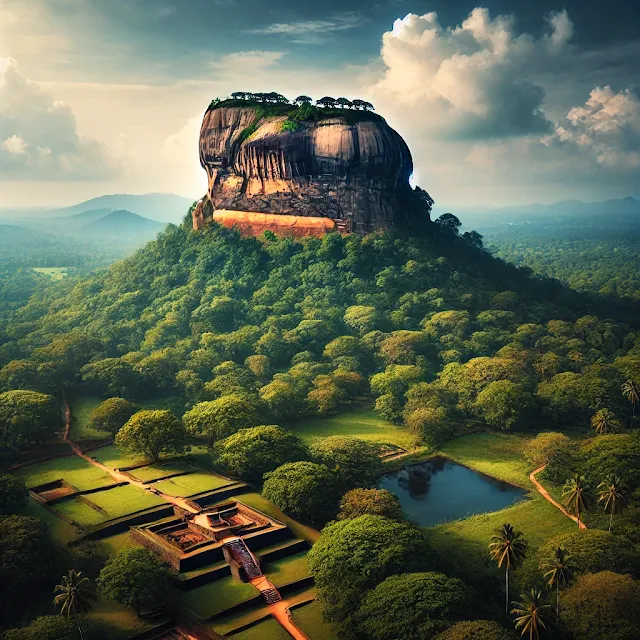Sigiriya: The Majestic
Lion Rock Fortress of
Sri Lanka
Introduction to Sigiriya
Sigiriya, often referred to as the "Lion Rock," is one of Sri Lanka's most iconic landmarks and a UNESCO World Heritage Site. Situated in the Matale District, near the town of Dambulla, this ancient rock fortress offers a remarkable blend of natural beauty, history, and architectural brilliance. Standing tall at nearly 200 meters, Sigiriya is an impressive site that draws thousands of visitors annually. In this article, we explore the history, significance, and must-see attractions of Sigiriya.
History of Sigiriya
Sigiriya's origins date back to the 5th century CE when King Kashyapa (477–495 CE) decided to establish a capital atop this massive rock. The king's vision was to create an impenetrable fortress while also ensuring that the palace would be a symbol of grandeur and power. Sigiriya was strategically chosen due to its natural defensive advantages and the ability to see invaders from miles away.
According to historical records, Sigiriya was inhabited even before King Kashyapa, as early as the prehistoric period, by Buddhist monks who used the caves and natural shelters around the base. After King Kashyapa's reign, Sigiriya became a Buddhist monastery until the 14th century.
Sigiriya's Significance
Sigiriya is not just a fortress; it is an outstanding example of ancient urban planning. The site is known for its intricate design, featuring landscaped gardens, water features, and advanced engineering techniques that are remarkable for their time. Sigiriya showcases a fusion of cultural, artistic, and technological innovations from ancient Sri Lanka.
The most famous feature of Sigiriya is its frescoes, which depict celestial maidens or apsaras. These vibrant paintings, which are still well-preserved, demonstrate the artistic talents of the ancient Sinhalese. Additionally, the mirror wall, once polished so finely that the king could see his reflection, is inscribed with poetry and thoughts from visitors dating back over a millennium.
Must-See Attractions in Sigiriya
1. The Lion’s Gate
The Lion’s Gate, located halfway up the rock, serves as the entrance to the summit. The massive paws of a lion carved into the stone give the fortress its name. Though only the paws remain today, it is believed that the entire structure was once a giant lion through which visitors had to pass.
2. The Sigiriya Frescoes
These colorful frescoes are located in a sheltered pocket of the rock, around 100 meters above ground level. The paintings depict women, often thought to be celestial beings, and are regarded as masterpieces of ancient Sri Lankan art. Despite being over 1,500 years old, many of the frescoes have survived in remarkable condition.
3. The Mirror Wall
This wall, which was originally covered with highly polished white plaster, allowed the king to see his reflection. Over the centuries, visitors have written poetry and verses on the wall, offering glimpses into the thoughts of ancient travelers.
4. Water Gardens
At the base of Sigiriya, visitors will find a series of beautifully designed gardens. These water gardens are sophisticated, with intricate hydraulic systems that controlled water flow, fountains, and ponds. The layout showcases advanced engineering skills and is a highlight of the site's ancient architecture.
5. The Summit and Royal Palace
Reaching the summit requires a steep climb, but the views from the top are well worth the effort. At the top, you'll find the ruins of the royal palace, which once housed King Kashyapa. The panoramic views of the surrounding landscape, with lush greenery stretching for miles, are breathtaking.
Tips for Visiting Sigiriya
- Best Time to Visit: The best time to visit Sigiriya is during the early morning or late afternoon to avoid the midday heat. The site opens at 7:00 AM, and arriving early will allow you to enjoy a quieter and cooler climb.
- Footwear: Wear comfortable shoes, as the climb to the top involves several steps and steep paths.
- Carry Water: Ensure you have enough water with you, especially if you're visiting during the hotter months.
- Guided Tours: Hiring a local guide is highly recommended as they can provide insightful information about the history and significance of Sigiriya.
Conclusion
Sigiriya stands as a testament to the ingenuity and creativity of ancient Sri Lanka. Whether you're a history buff, an art lover, or simply someone who appreciates natural beauty, Sigiriya is a must-visit destination. The rock fortress, with its rich history, remarkable architecture, and stunning views, offers a unique glimpse into the island's ancient past.

Comments
Post a Comment